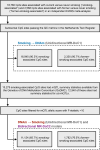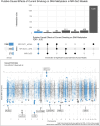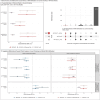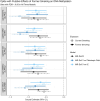Unidirectional and bidirectional causation between smoking and blood DNA methylation: evidence from twin-based Mendelian randomisation
- PMID: 39786687
- PMCID: PMC11799127
- DOI: 10.1007/s10654-024-01187-5
Unidirectional and bidirectional causation between smoking and blood DNA methylation: evidence from twin-based Mendelian randomisation
Abstract
Cigarette smoking is associated with numerous differentially-methylated genomic loci in multiple human tissues. These associations are often assumed to reflect the causal effects of smoking on DNA methylation (DNAm), which may underpin some of the adverse health sequelae of smoking. However, prior causal analyses with Mendelian Randomisation (MR) have found limited support for such effects. Here, we apply an integrated approach combining MR with twin causal models to examine causality between smoking and blood DNAm in the Netherlands Twin Register (N = 2577). Analyses revealed potential causal effects of current smoking on DNAm at > 500 sites in/near genes enriched for functional pathways relevant to known biological effects of smoking (e.g., hemopoiesis, cell- and neuro-development, and immune regulation). Notably, we also found evidence of reverse and bidirectional causation at several DNAm sites, suggesting that variation in DNAm at these sites may influence smoking liability. Seventeen of the loci with putative effects of DNAm on smoking showed highly specific enrichment for gene-regulatory functional elements in the brain, while the top three sites annotated to genes involved in G protein-coupled receptor signalling and innate immune response. These novel findings are partly attributable to the analyses of current smoking in twin models, rather than lifetime smoking typically examined in MR studies, as well as the increased statistical power achieved using multiallelic/polygenic scores as instrumental variables while controlling for potential horizontal pleiotropy. This study highlights the value of twin studies with genotypic and DNAm data for investigating causal relationships of DNAm with health and disease.
Keywords: Causal inference; DNA Methylation; Epigenetics; Mendelian Randomisation; Smoking; Twin modelling.
© 2025. The Author(s).
Conflict of interest statement
Declarations. Conflicts of interest: Nothing to declare.
Figures






Update of
-
Unidirectional and Bidirectional Causation between Smoking and Blood DNA Methylation: Evidence from Twin-based Mendelian Randomisation.medRxiv [Preprint]. 2024 Nov 22:2024.06.19.24309184. doi: 10.1101/2024.06.19.24309184. medRxiv. 2024. Update in: Eur J Epidemiol. 2025 Jan;40(1):55-69. doi: 10.1007/s10654-024-01187-5. PMID: 38946972 Free PMC article. Updated. Preprint.
Similar articles
-
Unidirectional and Bidirectional Causation between Smoking and Blood DNA Methylation: Evidence from Twin-based Mendelian Randomisation.medRxiv [Preprint]. 2024 Nov 22:2024.06.19.24309184. doi: 10.1101/2024.06.19.24309184. medRxiv. 2024. Update in: Eur J Epidemiol. 2025 Jan;40(1):55-69. doi: 10.1007/s10654-024-01187-5. PMID: 38946972 Free PMC article. Updated. Preprint.
-
Investigating causality in the association between DNA methylation and type 2 diabetes using bidirectional two-sample Mendelian randomisation.Diabetologia. 2023 Jul;66(7):1247-1259. doi: 10.1007/s00125-023-05914-7. Epub 2023 May 19. Diabetologia. 2023. PMID: 37202507 Free PMC article.
-
Extending Causality Tests with Genetic Instruments: An Integration of Mendelian Randomization with the Classical Twin Design.Behav Genet. 2018 Jul;48(4):337-349. doi: 10.1007/s10519-018-9904-4. Epub 2018 Jun 7. Behav Genet. 2018. PMID: 29882082 Free PMC article.
-
Using Mendelian randomisation to infer causality in depression and anxiety research.Depress Anxiety. 2013 Dec;30(12):1185-93. doi: 10.1002/da.22150. Epub 2013 Jul 11. Depress Anxiety. 2013. PMID: 23847157 Free PMC article. Review.
-
Mendelian Randomization and the Environmental Epigenetics of Health: a Systematic Review.Curr Environ Health Rep. 2019 Mar;6(1):38-51. doi: 10.1007/s40572-019-0226-3. Curr Environ Health Rep. 2019. PMID: 30773605
References
-
- Lawlor DA, Harbord RM, Sterne JA, Timpson N, Davey SG. Mendelian randomization: using genes as instruments for making causal inferences in epidemiology. Stat Med. 2008;27(8):1133–63. - PubMed
Publication types
MeSH terms
Grants and funding
LinkOut - more resources
Full Text Sources

